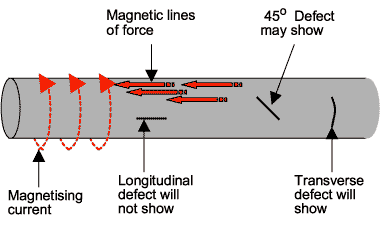Magnetic particle inspection (MPI) is a nondestructive test method that reveals irregularities on surfaces of iron and steel materials. As this is a non destructive testing method, it examines an object without altering its physical or chemical nature. Thus, the original quality and quantity of the material is preserved. There are other types of safe tests which don't alter the test object such as the liquid, penetrant inspection, x-ray inspection, and ultrasonic testing.
The process involves applying of fine magnetic particles on the test piece surface and the expected outcome is the accumulation of particles where there is a crack or seam. The particles are effectively influenced by tiny irregularities in magnetic fields. Thus, they can easily detect the presence of small leaks on surfaces. The magnetic powder can be spread out on a surface in two ways. The first way is through the use of dry powder and the other way is through a carrier (petroleum or water based) which renders the powder in suspension.
Dry powder is preferred in field inspections because it is more convenient, but the fluorescent suspension is the better option when detecting tiny cracks and seams because the particles this time are tinier and so it flows more easily along the surface to expose leakage fields. Wet magnetic particle inspection offers an advantage over dry magnetic particle inspection because the wet suspension can be spread evenly on the test surface. It must be noted that this is different than dye penetrant inspection because the principle observed in this process has something to do with magnetic field irregularities on surfaces.
The generation of magnetic field necessary for the testing can be generated by DC or AC circuits. Because AC circuits produce magnetic fields on surfaces, they are used when testing for presence of cracks on or near the surface of the sample. DC circuits, on the other hand, generate fields that penetrate deeper. Hence, they are used when testing samples for discontinuities below surfaces.
Magnetic particle inspection is applicable on raw materials at different phases of the process of manufacture and it can also be employed as a method for equipment maintenance. Finding tiny cracks on machinery is important in providing early solutions to signs of mechanical stress. This prevents big costs imposed by undetected equipment deterioration.
Although it can be employed for testing materials no matter how big they are, there are preferable methods for large parts.
The good thing about magnetic particle inspection is that it doesn't require parts to be thoroughly cleaned prior to inspection. Only degreasing for removal of oils on the surface may be necessary to yield reliable inspection results. After the inspection is carried out, the parts used during the test shall be demagnetized and cleaned to eliminate magnetic particles.
Magnetic particle inspection is just a means to examine objects as part of maintenance of equipment or machinery and other materials. The limitations of this method compel the use of other test methods for other purposes. For instance, industrial radiography and ultrasonic testing are used to check for deep flaws in materials.
Article Source: http://EzineArticles.com/5550275

0 Response to "Discovering Flaws By Using Magnetic Particle Inspection"
Post a Comment